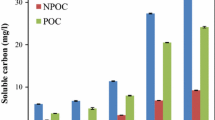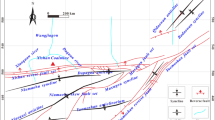Abstract
Coal is the world’s largest energy source for electricity generation and is mined on 6 continents. Sulfate contamination of surface and ground water from these mining and processing operations is well recognized and commonly monitored as a primary indicator of coal mining impact to surface water and groundwater. However, under conditions frequently found in natural waters, especially groundwater, sulfate can be reduced by naturally occurring sulfate-reducing bacteria, creating hydrogen sulfide. As many communities that are adjacent to these operations rely on groundwater as their primary potable water source, this hydrogen sulfide gas is a largely unrecognized contaminant. Recently, investigators have found connection between coal production and negative health consequences, including increased risk of respiratory diseases (Hendryx and Ahern, in Am. J. Public Health 98(4):669–671, 2008). Hydrogen sulfide is a contaminant associated with the same types of toxic effects as those found at increased prevalence in mining communities. This study of the central Appalachia region of the U.S. finds that when drinking water aquifers are contaminated, sulfide is liberated as a gas during domestic water use, creating conditions in coalfield homes where short-term and long-term exposures can exceed applicable health standards. Our investigation finds that this occurs at a concentration and frequency that warrants recognition by regulatory agencies and is monitored as commonly occurring mining-related contamination and a potential public health hazard.

Similar content being viewed by others
References
Ahlborg GG (1951) Hydrogen sulfide poisoning in shale oil industry. AMA Arch Ind Hyg Occup Med 3(3):247–266
Agency for Toxic Substances and Disease Registry (ATSDR) (2006) Toxicological Profile for Hydrogen Sulfide, July 2006
Allyn LB (1931) Notes on hydrogen sulfide poisoning. Ind Eng Chem 23(2):234
Ammann HM (1986) A new look at physiologic respiratory response to hydrogen sulfide poisoning. J Hazard Mater 13:369–374
Amoore JE, Hautala E (1983) Odor as an aid to chemical safety: odor thresholds compared with threshold limit values and volatilities for 214 industrial chemicals in air and water dilution. J Appl Toxicol 3:272–290
Anderson RM, Beer KM, Buckwalter TF, Clark ME, McAuley SD, Sams JI III, Williams DR (2000) Water Quality in the Allegheny and Monongahela River Basins Pennsylvania, West Virginia, New York, and Maryland, 1996–98: U.S. Geological Survey Circular 1202, 32 p., on-line at http://pubs.water.usgs.gov/circ1202/
Arnold IMF, Dufresne RM, Alleyne BC et al. (1985) Health implication of occupational exposures to hydrogen sulfide. J Occup Med 27:373–376
Audeau FM, Gnanaharan C, Davey K (1985) Hydrogen sulfide poisoning: associated with pelt processing. N Z Med J 98:145–147
Barnes LJ, Janssen FJ, Sherren J, Versteegh JH, Koch RO, Scheeren PJH (1991) A new process for the microbial removal of sulphate and heavy metals from contaminated waters extracted by a geohydrological control system. Trans IchemE 69(A)
Barns SM, Nierzwicki-Bauer SA (1997) Microbial diversity in ocean, surface and subsurface environments. In: Banfield JF, Nealson KH (eds) Geomicrobiology: interactions between microbes and minerals, chap 2. Review in mineralogy, vol 35. Mineralogical Society of America, Chantilly
Beauchamp RO Jr, Bus JS, Popp JA et al. (1984) A critical review of the literature on hydrogen sulfide toxicity. CRC Crit Rev Toxicol 13:25–97
Chance B, Schoener B (1965) High and low energy states of cytochromes. I. In mitochondria. J Biol Chem 241:4567–4573
Christison R (1845) A treatise on poisons to medical jurisprudence, physiology, and the practice of physic, 4th edn. Adams & Charles Black, Edinburgh, pp 806, 809
CICAD (2003) Hydrogen sulfide: human health aspects. Concise international chemical assessment document 53. International programme on chemical safety (IPCS), United Nations environment programme, international labor office. World Health Organization, Geneva
Dempsey BA, Paksuchon B, Suhataikul R, Dietz J (2002) Sampling strategies for TMDL of AMD-affected streams. In: Proceedings of a joint conference of ASMR, American society of mining and reclamation, 19th annual national conference 2002
Deng J-F, Chang S-C (1987) Hydrogen sulfide poisonings in hot-spring reservoir cleaning: two case reports. Am J Ind Med 11:447–450
Drever JI (1988) Geochemistry of natural waters, 2nd edn. Prentice Hall, New York
Drury WJ (1999) Treatment of acid mine drainage with anaerobic solid-substrate reactors. Water Environ Res 71(6)
Eychaner J (1999) Progress of environmental studies in coal mining areas of western Pennsylvania and central West Virginia; US Geological Survey. In: Proceedings twentieth annual West Virginia surface mine drainage task force symposium, 13–14 April 1999
Hao OJ, Chen JM, Huang L, Buglass RL (1996) Sulfate-reducing bacteria. Crit Rev Environ Sci Technol 26(1):155–187
Hathway GJ, Proctor NH, Hughes JP (1996) Hydrogen sulfide. Proctor and Hughes’ chemical hazards of the workplace, 4th edn. Van Nostrand Reinhold, New York, pp 350–352
Hendryx M, Ahern M (2008) Relations between health indicators and residential proximity to coal mining in West Virginia. Am J Publ Health 98(4):669–671
Hendryx M, Ahern M, Nurkiewicz T (2007) Hospitalization patterns associated with Appalachian coal mining. J Toxicol Environ Health, Part A 70(24):2064–2070
HSDB (1998) Hazardous Substances Data Bank. National Library of Medicine, National Toxicology Program, Bethesda, MD, 25 February 1998
IPCS (International Programme on Chemical Safety) (1981) Hydrogen Sulfide. World Health Organization, Geneva
Jaakkola JJ, Vilkka V, Marttila O, Jäppinen P, Haahtela T (1992) The south Karelia air pollution study: acute health effects of malodorous sulfur air pollutants released by a pulp mill. Am J Publ Health 82:603–606
Kieu HTQ, Muller E, Horn H (2011) Heavy metal removal in anaerobic semi-continuous stirred tank reactors by a consortium of sulfate-reducing bacteria. Water Res 45(13):3863–3870
Kilburn KH (1997) Exposure to reduced sulfur gases impairs neurobehavioral function. South Med J 90:997–1006
Kilburn KH, Warshaw RH (1995a) Epidemiology of adverse health effects from environmental chemicals, vol 34. Princeton Scientific Publishing, Princeton
Kilburn KH, Warshaw RH (1995b) Hydrogen sulfide and reduced-sulfur gases adversely affect neuropsychological functions. Toxicol Ind Health 11:185–197
Kilburn KH, Thrasher JD, Gray MR (2010) Low-level hydrogen sulfide and central nervous system dysfunction. Toxicol Ind Health 26(7):387–405
Krekel K (1964) Electrocardiographic (ECG) changes in two workers after hydrogen sulfide poisoning. Zentralbl Arbeitsmed 14:159–163
Langmuir D (1997) Aqueous environmental geochemistry. Prentice Hall, New York
Luck J, Kaye SB (1989) An unrecognized form of hydrogen sulfide keratoconjunctivitis. Br J Ind Med 46:748–749
Marrtila O, Jaakkola JJK, Partti-Pellinen K et al. (1995) South Karelia air pollution study: daily symptom intensity in relation to exposure levels of malodorous sulfur compounds from paper mills. Environ Res 71:122–127
Marshall T, Dorman D, Gardner D, Adeshina F (2009) Provisional advisory levels for hydrogen sulfide. Inhal Toxicol 21(S3):56–72
McCauley S, Kozar M, US Geological Survey (2006) Ground-Water Quality in Unmined Areas and Near Reclaimed Surface Coal Mines in the Northern and Central Appalachian Coal Regions, Pennsylvania and West Virginia. Scientific Investigations Report 2006-5059
Muyzer G, Stams AJ (2008) The ecology and biotechnology of sulfate-reducing bacteria. Nat Rev 6:441–454
Nagata T, Kage S, Kimura K et al. (1990) Sulfide concentrations in postmortem mammalian tissues. J Forensic Sci 35:706–712
Nealson KH, Stahl DA (1997) Microorganisms and biogeochemical cycles: what can we learn from layered microbial communities? In: Banfield JF, Nealson KH (eds) Geomicrobiology: interactions between microbes and minerals, chap 1. Review in mineralogy, vol 35. Mineralogical Society of America, Chantilly
Nicholls P (1975) The effect of sulphide on cytochrome aa3. Isoteric and allosteric shifts of the reduced a-peak. Biochim Biophys Acta 396:24–35
Oak Ridge National Laboratory (ORNL) (2012) Risk Assessment Information System. http://rais.ornl.gov/cgi-bin/prg/RISK_search, accessed August 29, 2012
Osbern LN, Crapo RO (1981) Dung lung: a report of toxic exposure to liquid manure. Ann Intern Med 95:312–314
Partti-Pellinen K, Marttila O, Vikka V et al. (1996) The south Karelia air pollution study: effects of low-level exposure to malodorous sulfur compounds on symptoms. Arch Environ Health 51:315–320
Perry KA (1995) Sulfate-reducing bacteria and immobilization of metals. Mar Georesour Geotechnol 13:33–39
Praharaj T, Fortin D (2004) Indicators of microbial sulfate reduction in acidic sulfide-rich mine tailings. Geomicrobiol J 21(7):457–467
Richardson DB (1995) Respiratory effects of chronic hydrogen sulfide exposure. Am J Ind Med 28:99–108
Sams J, Beer K (2000) Effects of coal-mine drainage on stream water quality in the Allegheny and Monongahela River Basins—sulfate transport and trends. USGS Water-Resources Investigations Report 99-4208
Sharon O, Skipton SO, Dvorak BI, Woldt W (2010) Drinking water: sulfur (sulfate and hydrogen sulfide). G1275, University of Nebraska
Simonton DS (2002) Stability of arsenic and selenium immobilized by in-situ microbial reduction. Doctoral Dissertation, University of New Mexico
Simonton S, Dimsha M, Thomson B, Barton L, Cathey G (2001) Long-term stability of metals immobilized by microbial reduction. In: Proceedings of the 2000 conference on hazardous waste research; great Plains/Rocky mountain hazardous waste research center
Skrtic L (2006) Hydrogen sulfide, oil & gas, and people’s health. Master’s Thesis, University of California, Berkeley
Smith L, Kruszyna H, Smith RP (1977) The effect of methemoglobin on the inhibition of cytochrome c oxidase by cyanide, sulfide and azide. Biochem Pharmacol 26:2247–2250
Stine RJ, Slosberg B, Beacham BE (1976) Hydrogen sulfide intoxication—a case report and discussion of treatment. Ann Intern Med 85:756
Thoman M (1969) Sewer gas: hydrogen sulfide intoxication. Clin Toxicol 2:383–386
Thomson B, Simonton D, Barton L (2002) Stability of arsenic and selenium immobilized by in situ microbial reduction. In: Proceedings of the 2001 conference on hazardous waste research, great Plains/Rocky mountain hazardous waste research center, February 2002
Ume N (2012) Alternative treatment technique for hydrogen sulfide and other contaminants in well water contaminated by mining related activities in southern West Virginia. Marshall University unpublished Master’s Degree project, May 2012
USEPA (1987) A new look at physiologic respiratory response to hydrogen sulfide poisoning. Office of research and development. US Environmental Protection Agency, Research Triangle Park
US Environmental Protection Agency (USEPA) (2003) Toxicological review of hydrogen sulfide (CAS No. 7783-06-4). In: Support of summary information on the integrated risk information system (IRIS), June 2003
Weisiger RA, Jakoby WB (1980) Thiol-S-methyltransferase from a rat liver. Arch Biochem Biophys 196:631–637
Wijnand E, Pearce N, Douwes J (2009) Chronic bronchitis, COPD, and lung function in farmers: the role of biological agents. CHEST, Sep 2009, vol 136, pp 716–725
WV Department of Environmental Protection (2012) Hydrologic Evaluation, Prenter Road Area, Boone County. WV, Triad Engineering Project 04-10-0323, January 2012
WV Department of Environmental Protection (2008) West Virginia Integrated Water Quality Monitoring and Assessment Report 2008
Author information
Authors and Affiliations
Corresponding author
Rights and permissions
About this article
Cite this article
Simonton, D.S., King, S. Hydrogen Sulfide Formation and Potential Health Consequences in Coal Mining Regions. Water Qual Expo Health 5, 85–92 (2013). https://doi.org/10.1007/s12403-013-0090-6
Received:
Revised:
Accepted:
Published:
Issue Date:
DOI: https://doi.org/10.1007/s12403-013-0090-6




